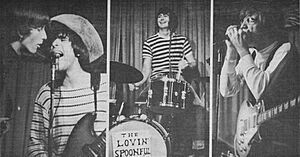The Lovin' Spoonful facts for kids
Quick facts for kids
The Lovin' Spoonful
|
|
|---|---|
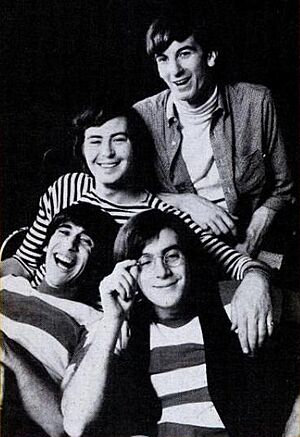
|
|
| Background information | |
| Origin | Greenwich Village, New York City, U.S. |
| Genres | |
| Years active |
|
| Members |
|
| Past members |
|
The Lovin' Spoonful was an American folk-rock band that started in Greenwich Village, New York City, in 1964. For a few years in the mid-1960s, they were one of the most popular groups in the United States. Their music and style inspired many other rock bands of that time.
Their first hit song, "Do You Believe in Magic", came out in July 1965. After that, they had seven songs in a row reach the Top Ten on the U.S. charts over the next 18 months. These included "Daydream" and "Did You Ever Have to Make Up Your Mind?", which both reached number two. Their song "Summer in the City" even hit number one!
The band was led by their main songwriter, John Sebastian. The Lovin' Spoonful got their early ideas from jug band and blues music, changing them into a popular music style. In 1965, they helped create the new music style called folk rock. By 1966, they were one of the most respected American bands. They were the third best-selling group for singles in the U.S. that year, right after the Beatles and the Rolling Stones.
As a new music style called psychedelia became popular in 1967, the Lovin' Spoonful found it hard to change their sound. Their sales went down, and the band broke up in 1968.
In 2000, the Lovin' Spoonful was added to the Rock and Roll Hall of Fame. This was a special moment where Sebastian, Yanovsky, Boone, and Butler played together one last time.
Contents
The Band's Story
How the Band Started (1964–1965)
Roots in Folk Music
The two main people who started The Lovin' Spoonful, John Sebastian and Zal Yanovsky, met on February 9, 1964. They were at a party hosted by their friend and fellow musician, Cass Elliot. That night, they watched the English band the Beatles perform on American TV for the first time on The Ed Sullivan Show.
All three musicians were part of the folk music scene in Greenwich Village, a neighborhood in New York City. Elliot encouraged Sebastian and Yanovsky to play music together. Like many folk musicians, they were very impressed by the Beatles' performance. Sebastian later said, "It affected us heavily."
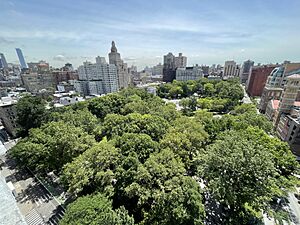
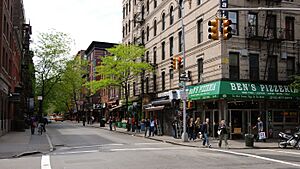
John Sebastian grew up in Greenwich Village, right next to Washington Square Park. He often played music in the park. He also played in rock bands when he was a teenager. He learned to play many instruments, like guitar, harmonica, piano, and the autoharp.
Zal Yanovsky grew up in Canada and was a guitar player in Toronto's folk music scene. He joined a folk group called the Halifax Three, which later moved to Greenwich Village. After that group broke up, Yanovsky and Sebastian both joined another group called the Mugwumps.
Sebastian really liked Yanovsky, saying he was "this kind of cultural weathervane." When they played live with the Mugwumps, Sebastian and Yanovsky often made up music together on the spot. After the Mugwumps broke up in late 1964, Sebastian and Yanovsky decided to start their own band. They wanted it to be an electric jug band.
Sebastian said they knew that music was changing. They felt that a four-person band who played their own instruments and wrote their own songs would be the next big thing. Yanovsky contacted Bob Cavallo, who used to manage their old bands. Cavallo agreed to manage their new group, even though they didn't have a name or any songs yet!
In 1964, Sebastian lived in an apartment in Little Italy, Manhattan. Erik Jacobsen, a musician who wanted to become a producer, moved in next door. They became friends because they both loved music. Jacobsen also liked the new sound of the Beatles. He started recording demo songs for musicians, including some of Sebastian's songs.
The First Band Members
From 1962 to 1964, Steve Boone played bass guitar in rock bands with drummer Joe Butler. In December 1964, Butler told Boone to come to a music club in Greenwich Village. There, Boone met Sebastian and Yanovsky. Even though Boone didn't know much about folk music, they quickly connected over their love for artists like Elvis Presley and the Beatles.
Sebastian played his song "Good Time Music" for Boone. The three musicians then played some Chuck Berry and R&B songs together. Boone was very impressed by Sebastian's playing and decided to join their new group.
The band still needed a drummer. Boone suggested Jan Carl, who had played with his old band. Carl managed a small inn on Long Island and offered it as a place for the band to practice during the winter. The band rehearsed there for several weeks in late 1964 and early 1965. They also played at local bars.
In early 1965, as they prepared for their first public shows, Sebastian, Yanovsky, Boone, and Carl kept practicing. Sebastian and Yanovsky looked for a band name. A friend suggested "The Lovin' Spoonful," which came from a song by the blues musician Mississippi John Hurt. Sebastian and Yanovsky loved the idea and chose it for the band.
Joe Marra, who owned the Night Owl Cafe in Greenwich Village, offered to book The Lovin' Spoonful. The band played their first live shows there in late January 1965 for two weeks. Their loud style in the small venue got mixed reactions. Marra wasn't impressed and went back to booking folk acts. The band's manager and producer suggested they practice more and get a new drummer. Carl was older than the others and didn't fit their style, so he was asked to leave.

After Carl left, the band needed a new practice space. They were living with their friend Cass Elliot at the Hotel Albert. The hotel let musicians practice in its basement. Joe Butler, who was still playing drums for another band, tried out for The Lovin' Spoonful in the Albert's basement. He impressed them with his energy, even breaking a drumstick but continuing to play with his hand. The band hired him as their new drummer.
While waiting for a record deal, The Lovin' Spoonful played at clubs on MacDougal Street in Greenwich Village. They played many sets a night, six days a week, at Café Bizarre. Sebastian later said they learned a lot at that small club. Joe Marra, who had been critical before, was impressed by their new professional sound. In May 1965, he invited them back to the Night Owl.
The Lovin' Spoonful shared the stage with other electric bands, and their shows became very popular. Other famous musicians, like members of the Byrds, sometimes came to watch them play.
The Rise of Folk Rock
In June 1965, The Lovin' Spoonful played at Club 47, a folk music club in Massachusetts. Steve Boone was unsure about playing at a folk club, but Sebastian and Yanovsky were excited to challenge the folk fans. They wanted to show them their new sound.
They played there after hearing about Bob Dylan's recent move to electric rock and the popularity of the Byrds' folk rock cover of Dylan's song "Mr. Tambourine Man". The term "folk rock" had just been created in a music magazine to describe this new style. The magazine even mentioned The Lovin' Spoonful as a band with a "folk-rock sound," even though they hadn't released any records yet.
The Lovin' Spoonful played two sets at Club 47. At first, some folk fans left because the band was too loud. Sebastian remembered a woman putting her fingers in her ears, and Yanovsky just smiled and turned his amplifier up even louder! But during the second set, the crowd that stayed loved their music. Many people now see this performance as a very important moment in the history of folk rock.
Becoming Popular (1965–1966)
First Album and Tours
When "Do You Believe in Magic" came out in July 1965, The Lovin' Spoonful quickly became famous across the U.S. They appeared on popular TV shows like American Bandstand.
The band started touring outside of New York City. In August, they toured the West Coast. They played for 35,000 people at the Rose Bowl in California, opening for the English pop group Herman's Hermits. They also played at famous clubs in Los Angeles like the Whisky a Go Go.
The Lovin' Spoonful returned to the West Coast in October 1965. They played at the hungry i nightclub, a very famous folk club. On October 24, they played a dance party in San Francisco that combined rock music with light shows. This was one of the first events in the new San Francisco music scene. Members of the Grateful Dead, who were an acoustic folk group, were there. They were so inspired by The Lovin' Spoonful that they decided to "go electric" with their own music.
While touring, The Lovin' Spoonful recorded songs for their first album, Do You Believe in Magic. They recorded 13 songs quickly between June and September 1965. Most of the songs were jug band and blues covers they played live. The album also had five new songs written by Sebastian. One of them, "Did You Ever Have to Make Up Your Mind?", was based on a childhood memory. The album was released in November 1965 and reached number 71 on the Billboard charts.
By late 1965, The Lovin' Spoonful had appeared on many popular American TV shows. Executives from NBC even offered the band a chance to star in their own TV series, The Monkees. The show would be a comedy about a band trying to become famous, like the Beatles' movie A Hard Day's Night. The band was excited about becoming famous quickly, but they didn't want to change their name to "The Monkees." They also worried they wouldn't be able to create and play their own music. So, they turned down the offer.
The Daydream Album
In November 1965, The Lovin' Spoonful went on a 19-day tour with the American girl group the Supremes. They traveled by bus and had fun together. The tour was tiring, and Sebastian missed his girlfriend. To cheer himself up, he wrote the song "Daydream" while on the bus. He was inspired by the Supremes' songs.
After their tour, The Lovin' Spoonful went to Los Angeles to appear in a concert film. They also stayed for several weeks to play at a nightclub called The Trip. They became friends with David Crosby of the Byrds, who often told reporters that The Lovin' Spoonful would be the next big group.
The Lovin' Spoonful recorded most of their second album, Daydream, in just four days in December 1965. Some songs were recorded earlier, like "You Didn't Have to Be So Nice". This song was released as a single in November and reached number ten on the charts.
Unlike their first album, which had only five original songs, Daydream had eleven original tracks. The album was released in March 1966 and reached number ten on the Billboard album chart, becoming their most successful studio album.
Sebastian and Yanovsky hoped their song "It's Not Time Now" would be a single, but the record label said no because they thought it sounded like a protest song. Instead, "Daydream" was released as a single in February 1966.
"Daydream" stayed on the charts for twelve weeks and reached number two. It was kept from number one by another song, but it did reach number one on Cash Box magazine's chart and in Canada. The song's success made The Lovin' Spoonful even more popular. When they toured with the Beach Boys in April 1966, the two groups took turns being the main act.
Global Success (1966)
Movie Soundtrack and European Tour
Even though The Lovin' Spoonful was very popular in North America, they weren't well known in the U.K. Their songs hadn't made it onto the charts there. To help them become famous around the world, their managers planned concerts and TV appearances in England and Sweden for April 1966.
Just days before they were supposed to leave, they were asked to create a soundtrack for What's Up, Tiger Lily?, a movie directed by comedian Woody Allen. The band recorded the soundtrack in two days. The movie wasn't a big hit, and the soundtrack album only reached number 126 on the charts.
On April 12, The Lovin' Spoonful arrived in England for their ten-day tour. They played concerts and appeared on TV shows like Top of the Pops. They also met many of Britain's top musicians. At a show in London, famous artists like John Lennon, George Harrison, Ray Davies, and Eric Clapton came to watch them play. The band was very well received.
After flying to Sweden to perform on TV, The Lovin' Spoonful went to Ireland for a private show at a birthday party. The band was flown there at the host's expense. Many famous people from the "Swinging London" scene were there, including members of the Rolling Stones.
The Lovin' Spoonful returned to the U.S. at the end of April. The band felt great after the tour, especially since other famous musicians treated them as equals. "Daydream" became a big hit around the world. By mid-May, it was number two on all the major British charts and number one in Sweden.
"Summer in the City" and Hums of the Lovin' Spoonful
After recording two albums in 1965, The Lovin' Spoonful needed new songs in March 1966. Sebastian remembered a song his 14-year-old brother, Mark, had written. Sebastian changed the words and music to create "Summer in the City". Other band members also helped.
Before "Summer in the City" was released, "Did You Ever Have to Make Up Your Mind?" came out in April. It reached number two in June, making it their fourth Top Ten hit in America. "Summer in the City" was released as a single on July 4, 1966. On August 13, it became The Lovin' Spoonful's first and only number one song in the U.S. It stayed at number one for three weeks. The song also topped charts in Canada.
"Summer in the City" was a very modern pop song for its time. When The Lovin' Spoonful played it live, Sebastian couldn't sing and play the piano part at the same time, so Joe Butler sang the main part instead. Even though "Daydream" was a big hit in the U.K., "Summer in the City" only reached number eight on the British charts.
In July 1966, The Lovin' Spoonful played at the Newport Folk Festival in Rhode Island for 65,000 people. The year before, Bob Dylan had caused a stir by playing electric rock. But in 1966, The Lovin' Spoonful and other electric bands were welcomed. A critic from The New York Times said their warm welcome showed that folk-rock was becoming more accepted.
The band started recording their third album, Hums of the Lovin' Spoonful, in August 1966. They recorded it in New York City and Los Angeles. This was the first album where all the songs were original. The album was released in November 1966 and reached number 14 on the Billboard album chart.
One song from Hums of the Lovin' Spoonful was "Rain on the Roof". The band members disagreed about releasing it as a single. "Summer in the City" had a harder sound and brought new fans. Steve Boone and Joe Butler worried that going back to a softer sound would make new fans leave. But Sebastian said they should try different sounds. "Rain on the Roof" was released in October and reached number ten, making it their sixth Top Ten hit in a row.
Another song from the album, the country-style "Nashville Cats", was released as a single in December. It reached number eight. In 1966, The Lovin' Spoonful had five Top Ten songs, making it their most successful year.
Later Years and Breakup (1967–1968)
Movie Soundtrack and Band Changes
In October 1966, The Lovin' Spoonful recorded a soundtrack album for the 1966 movie You're a Big Boy Now. Sebastian wrote the songs for the film. One song, "Darling Be Home Soon", was about a man waiting for a woman to come home. The band recorded the song quickly.
The band members were not happy about the lack of teamwork on the movie soundtrack. Zal Yanovsky especially disliked "Darling Be Home Soon." When the band performed the song on The Ed Sullivan Show in January 1967, Yanovsky made funny faces and bounced around with a rubber frog on his guitar. This made the audience laugh but made Sebastian angry.
"Darling Be Home Soon" only reached number fifteen, which was a big disappointment compared to their earlier hits. The movie soundtrack album also didn't sell well. However, the band's first greatest hits album, The Best of The Lovin' Spoonful, released in March 1967, was a huge success, reaching number three on the charts.
By early 1967, Sebastian's bandmates felt he was controlling too much of the band's direction. The relationship between Sebastian and Yanovsky became difficult. In May 1967, Sebastian, Butler, and Boone met to talk about the band's future. Sebastian was frustrated with Yanovsky's behavior and said either Yanovsky had to go, or he would leave. Butler agreed. The band told Yanovsky he was fired, but he agreed to play their last few scheduled shows. His last public performance with The Lovin' Spoonful was on June 24, 1967.
New Member and Album
The Lovin' Spoonful hired Jerry Yester to replace Yanovsky on lead guitar. Yester had been friends with the band for years. He joined the band in early June 1967 and played his first show with them on June 30.
The band started recording their next album, Everything Playing, in August 1967. They had a new producer and used a new 16-track recording machine. Like other folk-rock bands, The Lovin' Spoonful found it hard to change their music as psychedelic music became popular in 1967.
The album produced three singles, but none of them reached the Top Ten. "Six O'Clock" reached number 18. "She Is Still a Mystery" reached number 27. Everything Playing was released in December 1967 but got negative reviews and only reached number 118 on the charts. Another song, "Money," was released as a single in January 1968 and reached number 48.
Sebastian Leaves the Band
After the disappointing sales of Everything Playing and "Money" in early 1968, Sebastian told his bandmates he planned to leave the group after their next three months of concerts. He played his last public show with the band on June 20, 1968. His departure was announced in September. By December, a British music magazine reported that The Lovin' Spoonful had broken up. Sebastian later said the band had "two glorious years and a tedious one."
After Sebastian left, the remaining band members didn't have much contact. Joe Butler got permission to record an album under The Lovin' Spoonful's name. This album, Revelation: Revolution '69, was released in late 1968. It didn't feature Boone or Yester and didn't make it onto the charts.
After the Breakup and Reunions
After The Lovin' Spoonful broke up, John Sebastian was the only member whose music career seemed promising at first. He wrote music for a Broadway show and released a solo album, John B. Sebastian, which reached number 20 on the charts. He was even offered a spot in the supergroup Crosby, Stills & Nash, but he wanted to focus on his solo career. Sebastian played at the famous Woodstock festival in August 1969, performing some Lovin' Spoonful songs.
Zal Yanovsky also released a solo album, Alive and Well in Argentina, in 1968, but it didn't get much attention. He later worked with Jerry Yester to produce music for other artists. Yanovsky eventually left the music business and opened a restaurant in Canada.
Steve Boone tried to record a solo album but it didn't work out. He then left the music business. Joe Butler became an actor on Broadway and also worked as a sound editor in Hollywood. Later, he drove a taxi.
Sebastian didn't want to reunite The Lovin' Spoonful for a long time. The original members only got back together twice. In 1979, they appeared in a movie called One-Trick Pony. They didn't see each other again until March 2000, when all four original members were inducted into the Rock and Roll Hall of Fame. Yanovsky passed away two years later.
Joe Butler, Steve Boone, and Jerry Yester started touring as The Lovin' Spoonful again in 1991. They released a live album in 1999. Sebastian has joined Boone and Butler on stage once since then, in 2020, for a benefit concert.
Music Style
The Lovin' Spoonful's music was led by their main songwriter, John Sebastian. They were first inspired by blues and jug band music. Their sound mixed folk, blues, country, and rock, making traditional American music sound modern and popular. Sebastian said that the music of Jim Kweskin and the Jug Band was very important to them.
Sebastian's songwriting drew from American pop, rock, and folk music. He said that Motown music was one of his biggest influences. He also looked up to his friend Fred Neil, who wrote songs that sounded "effortless." The Lovin' Spoonful's first album included covers of songs by other folk and blues artists.
The Lovin' Spoonful's sound influenced many other bands, like the Beatles, the Beach Boys, the Kinks, Buffalo Springfield, and the Grateful Dead. They were one of the first bands to be called "folk rock," a term created in June 1965. They were a key band in the folk-rock movement in New York City and became the most successful folk-rock band from the East Coast of the U.S.
Unlike the protest songs that folk music was known for, The Lovin' Spoonful focused on happy, feel-good music. They often called their sound "good-time music." Sebastian hoped this phrase would be an alternative to "folk rock," which he felt didn't fully describe their sound.
Even though they came from folk music, Sebastian and Yanovsky loved early rock and roll. Sebastian remembered that when they first met, he was amazed by Yanovsky's guitar playing, which was "all over the place." Yanovsky's playing used a lot of improvisation and often included country music styles.
In the Studio
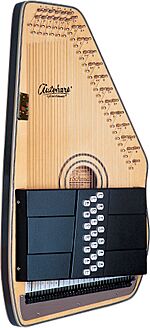
The Lovin' Spoonful played on all their own recordings and didn't use other studio musicians. They wanted each song to sound different. To do this, they used many different instruments in their recordings, including bass marimba, chimes, Irish harp, and a Hohner Tubon. They also used different types of guitars.
The band often used the autoharp, a stringed instrument with buttons that play chords. This instrument was mostly used in folk music, but few rock bands used it. Sebastian made his autoharp louder by attaching a microphone to it and plugging it into an amplifier. They also added piano sounds to make the autoharp sound bigger.
Sebastian played a 1957 Gibson Les Paul electric guitar in live shows and on recordings. Yanovsky's main guitar was a Guild Thunderbird. He also sometimes played a Fender Esquire. He liked to use a Fender Super Reverb amplifier, which made his guitar sound loud and full.
Band Image
The Lovin' Spoonful's style influenced other bands of their time. Their stage shows were fun and energetic, especially because of Yanovsky. He was known for wearing ripped jeans, T-shirts, and acting wild on stage, which later became common for rock guitarists. One magazine described their look as a mix of Beatniks and the Beatles.
The band wore clothes with stripes and spots. Sebastian often wore denim and granny glasses, which he got from a friend. John Lennon later started wearing similar glasses. After meeting a fashion designer, Jeannie Franklyn, in December 1965, she designed special clothes for Yanovsky. Yanovsky is known for being one of the first rock musicians to wear cowboy hats and fringed buckskin jackets. He also wore fur coats, mod ties, and vests.
Members
Current members
- Steve Boone – bass guitar, keyboards (1964–1968, 1991–present)
Past members
- John Sebastian – guitar, harmonica, autoharp, keyboards, vocals (1964–1968)
- Zal Yanovsky – guitar, vocals (1964–1967; died 2002)
- Jan Carl – drums (1964–1965)
- Joe Butler – drums, vocals (1965–1968, 1991–2023)
- Jerry Yester – guitar (1967–1968, 1991–2017)
Membership timeline

Discography
Studio albums
- Do You Believe in Magic (1965)
- Daydream (1966)
- Hums of the Lovin' Spoonful (1966)
- Everything Playing (1967)
- Revelation: Revolution '69 (1968)
Soundtrack albums
- What's Up, Tiger Lily? (1966)
- You're a Big Boy Now (1967)


